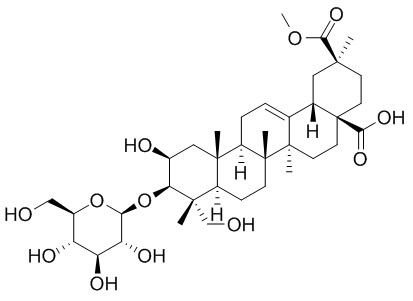Esculentoside D
Reference standards.
Inquire / Order:
manager@chemfaces.com
Technical Inquiries:
service@chemfaces.com
Tel:
+86-27-84237783
Fax:
+86-27-84254680
Address:
1 Building, No. 83, CheCheng Rd., Wuhan Economic and Technological Development Zone, Wuhan, Hubei 430056, PRC
Providing storage is as stated on the product vial and the vial is kept tightly sealed, the product can be stored for up to
24 months(2-8C).
Wherever possible, you should prepare and use solutions on the same day. However, if you need to make up stock solutions in advance, we recommend that you store the solution as aliquots in tightly sealed vials at -20C. Generally, these will be useable for up to two weeks. Before use, and prior to opening the vial we recommend that you allow your product to equilibrate to room temperature for at least 1 hour.
Need more advice on solubility, usage and handling? Please email to: service@chemfaces.com
The packaging of the product may have turned upside down during transportation, resulting in the natural compounds adhering to the neck or cap of the vial. take the vial out of its packaging and gently shake to let the compounds fall to the bottom of the vial. for liquid products, centrifuge at 200-500 RPM to gather the liquid at the bottom of the vial. try to avoid loss or contamination during handling.
Vietnam Journal of Food Control.2022, 5(3):pp.488-497.
Phytomedicine.2022, 102:154183.
Research Square2023, 2883170.
Saudi Pharm J2020, 10.1016
GxABT2022, 2268.2:15515.
Food Chem.2024, 460(Pt 1):140472.
J Herbmed Pharmacol.2018, 7(4):280-286
Sci Rep.2019, 9(1):4342
Molecules.2024, 29(3):671.
Antioxidants (Basel).2022, 11(12):2496.
Related and Featured Products
Journal of Liquid Chromatography & Related Technologies, 2010, 33(4):563-571.
SEPARATION AND PURIFICATION OF TRITERPENE SAPONINS FROM ROOTS OF RADIX PHYTOLACCAE BY HIGH-SPEED COUNTERCURRENT CHROMATOGRAPHY COUPLED WITH EVAPORATIVE LIGHT SCATTERING DETECTION.[Reference:
WebLink]
METHODS AND RESULTS:
Coupled with evaporative light scattering detection, high-speed countercurrent chromatography was successfully applied for the first time for separation and purification of four triterpene saponins including esculentosides A, B, C, and D from the roots of Radix phytolaccae. The separation was performed with an optimized two-phase solvent system composed of chloroform-methanol-water (4:4:2,v/v), using the lower phase as the mobile phase at a flow rate of 1.5 mL/min. From 150 mg of crude extract, 46.3 mg of esculentoside A, 21.8 mg of esculentoside B, 7.3 mg of esculentoside C, and 13.6 mg of Esculentoside D were obtained at purities of 96.7%, 99.2%, 96.5%, and 97.8%, respectively, as determined by HPLC analysis.
CONCLUSIONS:
The structures of the four triterpene saponins were identified by ESI-MS,1H NMR and 13C NMR.



